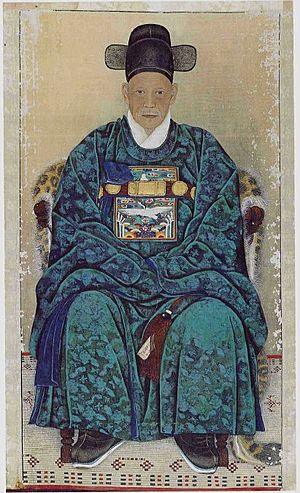Choe Ik-hyeon facts for kids
Quick facts for kids
Choe Ik-hyeon
최익현 of the Gyeongju Choe clan
|
|
|---|---|

Portrait of Choe Ik-hyeon by artist Chae Yong-shin
|
|
| Born | 1833 Gachae, Naebuk-myeon, Pocheon-hyeon, Gyeonggi-do, Kingdom of Joseon
(nowadays Gaechae-ri, Sinbuk-myeon, Pocheon-si, Gyeonggi-do, South Korea) |
| Died | 1906 (aged 72) |
| Nationality | |
| Other names | Choi Ik-hyeon / Choi Ik-hyun |
| Education | Past Royal Exam in 1855 |
| Occupation | Scholar Politician Philosopher Independence Activist General of the Korean Righteous Army guerrilla forces |
| Years active | ?–? |
| Known for | Become the strong supporter of Neo-Confucianism and defended Korean sovereignty in the face of Japanese imperialism. |
| Political party | Westerners |
| Children | Choe Yeong-jo (1st son) Choe Yeong-hak (2nd son) Choe Yeong-bok (3rd son) |
| Parent(s) |
|
| Relatives | Choe Chang-kyoo (grandson) |
| Awards | 1962 Medal of Merit for the Republic of Korea (1962년 건국훈장 대한민국장 추서) |
| Korean name | |
| Hangul | |
| Hanja | |
| Revised Romanization | Choi Ik-hyeon |
| McCune–Reischauer | Ch'oe Ik-hyŏn |
| Art name | |
| Hangul | |
| Hanja | |
| Revised Romanization | Myeonam |
| McCune–Reischauer | Myŏnam |
| Childhood name | |
| Hangul | |
| Revised Romanization | Ch'oe Gi-nam |
| McCune–Reischauer | Choi Ki-nam |
| Courtesy name | |
| Hangul | |
| Revised Romanization | Changyeom |
| McCune–Reischauer | Ch'ankyŏm |
Choe Ik-hyeon (Korean: 최익현; Hanja: 崔益鉉; 1833–1906) was an important Korean scholar, politician, and general. He lived during the Joseon Dynasty and was a strong believer in Confucianism. Choe Ik-hyeon was also a fierce nationalist who fought to protect Korea's independence from Japanese influence.
Contents
Early Life and Government Work
Choe Ik-hyeon was born in Pocheon city, Gyeonggi Province. He passed a special government exam in 1855. This allowed him to become a government official.
He worked for King Cheoljong of Joseon and later for the King's father, Heungseon Daewongun. After that, he served King Gojong.
Speaking Out Against Daewongun
In 1872, King Gojong was old enough to rule. But his father, Daewongun, who was acting as a regent (someone who rules for a young king), didn't want to give up his power.
Choe Ik-hyeon, who was a junior minister, bravely spoke out against Daewongun. He pointed out many things Daewongun had done wrong. These included selling government jobs and using people's taxes to rebuild a palace. He also criticized Daewongun for closing Confucian academies and failing to stop foreign ships.
Even though Choe and Daewongun both disliked foreign influence, Choe was very upset with Daewongun's actions. Choe also had support from the family of the future Queen Myeongseong.
Because Choe spoke out, Daewongun's supporters sent him away to Jeju Island. However, Choe's actions encouraged others to speak up. This led to Daewongun stepping down from power. Soon after, King Gojong brought Choe back into the government.
Opposing the Kanghwa Treaty
In 1876, King Gojong asked his advisors for their thoughts on a new agreement. This was the Japan–Korea Treaty of 1876. This treaty would open Korea's doors to Japan.
Choe Ik-hyeon strongly opposed this treaty. He believed it would harm Korea. He worried it would bring in Western ideas like Catholicism and allow Japanese goods to flood Korean markets. Because he spoke out so strongly, the Japanese removed him from his government position after the treaty was signed.
After this, Choe began to promote traditional Uijong Jeoksa movements. These movements aimed to bring back Confucian values and get rid of foreign (Western and Japanese) ideas.
Protecting Korean Values
From 1876 to 1894, Choe Ik-hyeon and other traditional scholars led anti-Japanese movements. They wanted to remove all foreign influences from Korea. They also wanted to bring back traditional Confucian values.
These movements were often violent. Choe and his followers saw the Japanese as "western barbarians" because they adopted Western ways.
Leading the Righteous Army
In 1895, Queen Min was tragically killed. After this, Japanese-backed reformers made the King sign a rule. This rule said all Korean men had to cut off their traditional topknot hairstyle.
Choe Ik-hyeon and other Confucian officials were furious. Choe famously declared he would rather lose his head than cut his hair. He and his friends led armed resistance groups. These groups were known as the Righteous Army. They attacked Japanese soldiers, merchants, and Koreans who supported Japan.
Choe's Call to Fight and Exile
After the Japan–Korea Treaty of 1905, Korea became a "protectorate" of Japan. This meant Japan controlled many of Korea's affairs. Choe Ik-hyeon, who was 70 years old, wrote a letter to Emperor Gojong. He begged the Emperor to fight back against the Japanese.
Soon after, Choe wrote An Appeal to Arms. This was a message to all Korean people. It urged them to pick up weapons and fight against the Japanese invasion. It also called for them to restart the spirit of the Righteous Army.
Choe quickly gathered 400 supporters. He personally fought the Japanese in Taein and later in Sunchang County in 1906. However, he was soon arrested. He was sent to Tsushima Island in Japan. There, he refused to eat the food given to him by the Japanese. He died in exile three months later.
Legacy
Choe Ik-hyeon's efforts helped keep the Righteous Army Movement going until 1911, years after his death. He inspired many with his strong sense of nationalism and his hatred for Japan. His writings, collected in Myunam Jip, were saved by his students. This happened even though Japanese officials tried to get rid of nationalistic books.
See also
- Song Si-yeol
- Korean independence movement

